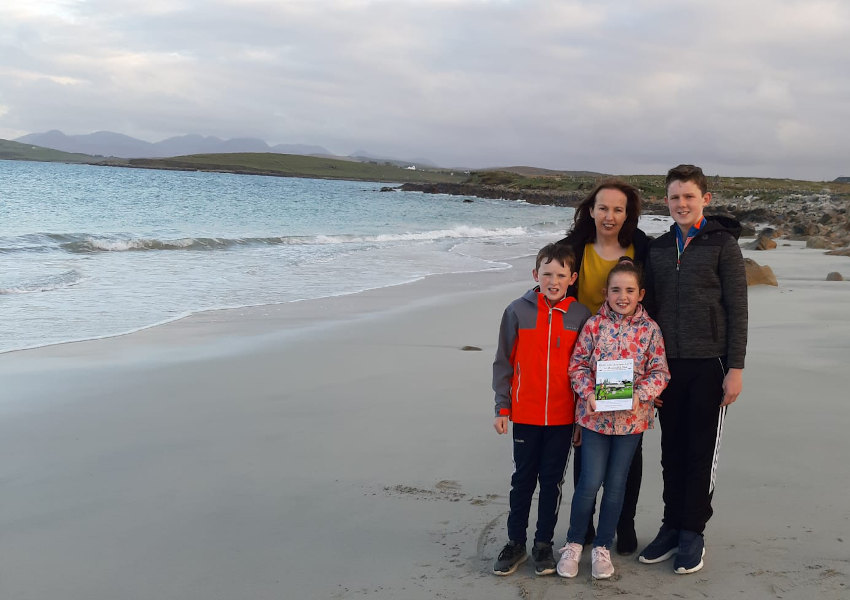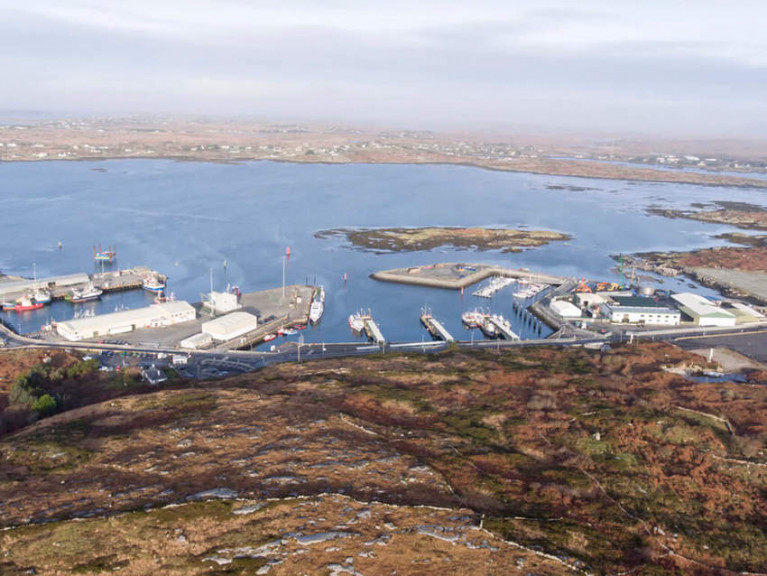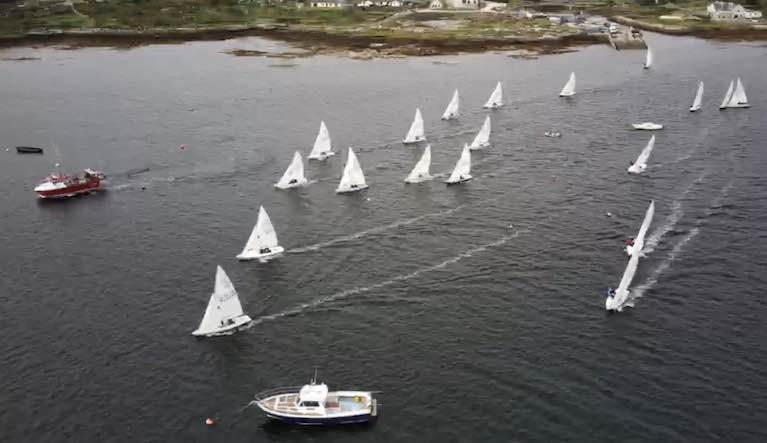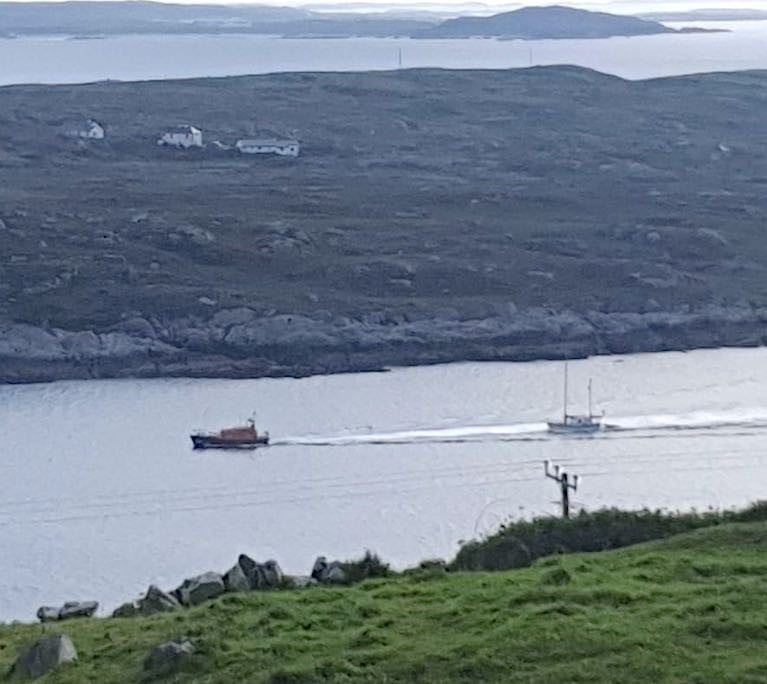Displaying items by tag: Connemara
Loggerhead Turtle Dies in Galway After Being Blown Off Course From Canary Islands
A loggerhead turtle believed to originate from the waters around the Canary Islands has died despite the best efforts of Galway Atlantaquaria staff after it was found washed ashore in Connemara.
As RTÉ News reports, the 50kg turtle was discovered on Muighinis Beach near Carna in a comatose state and on the advice of the Irish Whale and Dolphin Group was taken to the national aquarium in Salthill.
However, Galway Atlantaquaria confirmed on social media that the adult female loggerhead turtle “never regained consciousness”.
It’s suspected that the turtle, who had been named Macdara after the patron saint of Connemara fishers, was blown off course during Storm Barra earlier this month into the colder North Atlantic.
Farmed Salmon Found in Wild Salmon River “Serious Cause for Concern” in Connemara, IFI Says
The State agency responsible for the protection of freshwater fish and habitats is investigating an incidence of farmed salmon recovered from the Connemara Fishery.
Officers from Inland Fisheries Ireland’s (IFI) Western River Basin District in Galway were alerted by anglers fishing for wild Atlantic salmon on the Dawros River in Letterfrack, more commonly known locally as the Kylemore River.
The anglers had reportedly captured fish with poorly formed fins and other distinguishing features associated with farmed salmon.
Scientists from IFI inspected various fish samples from the river and have confirmed that the fish are of “aquaculture origin” and are not wild Atlantic salmon.
The discovery is a serious cause for concern for IFI, according to its head of operations Dr Greg Forde.
“The Dawros Rivers have been designated a special area for conservation for wild Atlantic salmon and we are seriously concerned about the impact that farmed salmon could have on this native species,” he said.
“For example, farmed salmon could potentially transfer disease or could interbreed with the indigenous wild salmon population of this river.
“Salmon spawn during the month of December and each river has a genetically unique salmon stock. Early indications are that the farmed salmon, due to their size and development, could be capable of spawning this winter and interbreeding with wild fish, thereby weakening the natural genetic pool unique to the Dawros River.”
IFI says its investigations to determine the source of the escape are ongoing. The State agency has notified the Department of Agriculture, Food and the Marine, which is responsible for the issuing of aquaculture licences.
In an appeal to owners and operators of salmon fish farms around the country, Dr Forde said: “To protect and conserve wild Atlantic salmon for both current and future generations, it is absolutely essential that all salmon aquaculture installations are completely secure and farmed fish are not allowed to escape into the wild.”
Connemara Gaeltacht Harbour Could Become Hub for Marine Renewable Energy
Ros an Mhíl/Rossaveal could become a hub for marine renewable energy projects, if plans by Údarás na Gaeltachta come to fruition.
The board of the Gaeltacht authority has recently approved funding to plan the development of a 30-acre site it owns near the Connemara harbour.
Údarás na Gaeltachta says its study will include a review of the marine renewable energy sector and its potential opportunities, as well as “the requirements and advantages that Ros an Mhíl harbour and Gaeltacht companies have to meet future demands and to benefit from same”.
The organisation says renewable energy will be central to its 2021-2025 strategy, which is set for publication early next year, adding that Ros an Mhíl “has been long identified by Údarás na Gaeltachta as a strategic resource”.
Chair of the board Anna Ní Ghallachair said: “We are happy that Údarás na Gaeltachta will be in a position to undertake this study on the opportunities for renewable energy in the Ros an Mhíl area.
“This is a strategic sector for Údarás, and indeed for the whole country. If we are to halt climate change, we must avail of all opportunities there are to generate clean energy.”
Údarás na Gaeltachta hopes to issue tenders on etenders in the weeks ahead so that work can commence early in the new year.
The news comes after similar moves have been mooted for the Shannon Estuary, while in Cork a new strategic partnership aims to improve communication with the wider marine community as the pace of offshore wind farm development picks up.
Launch of New Irish Children’s Book on Connemara is a Boost to Clifden Lifeboat Team
A new children’s book focusing on the local history and mythology of the North West Connemara region has been launched this week in Co Galway.
And a portion of the proceeds is being donated to the Clifden RNLI lifeboats for their dedication to saving lives at sea.
Local author and youth worker Marie Feeney has produced From Our Ancient Land to Bountiful Sea, an informative and often humorous collection of local history and folklore tales with illustrations by Gary Kendellen.
These tales include accounts of the famous engineer Alexander Nimmo, who designed many piers and bridges in the Connemara area, and a blend of local history and myths that will appeal to locals and visitors alike.
Marie’s first book The Cleggan Disaster comprehensively and poignantly detailed the tragic drowning of 45 men from the fishing communities of Cleggan, Claddaghduff and Inishbofin and the Inishkeas, and also benefitted the local RNLI lifeboats.
 Author Marie Feeney with her children Ronan, Diarmuid and Michaela at Sallerna Beach in Cleggan, Co Galway | Photo: Marie Feeney
Author Marie Feeney with her children Ronan, Diarmuid and Michaela at Sallerna Beach in Cleggan, Co Galway | Photo: Marie Feeney
On the launch of her new book, Marie said: “The coastline of Connemara, while exceptionally beautiful is also treacherous and mostly utilised by people who use it either for pleasure or their livelihood.
“Thankfully in our community, we have a dedicated RNLI volunteer team who provide an invaluable service by saving lives each year, sometimes in the most challenging environments.
“The philosophy of the RNLI is astounding. The purpose to save lives, their vision to save everyone, their volunteer ethos, their charitable and community base. Every life matters, and of course their maritime expertise is crucial.”
From Our Ancient Land to Bountiful Sea is now on sale locally in Connemara at The Clifden Bookshop, Letterfrack Country Shop, Gala Cleggan and Sweeney’s Claddaghduff. The book is also available online at the inConnemara Bookshop.
Airstrip is the Answer for Homeless Cleggan Coast Guard, Says TD
Cleggan Coast Guard in Connemara is long overdue a permanent base — and a local TD insists the village’s airstrip is the answer.
As the Connacht Tribune reports, Éamon Ó Cuív says it is unacceptable that the coastguard service for north Connemara has been seeking a fixed abode for so long.
A number of sites are being considered by the OPW — but Deputy Ó Cuív says none would be more suitable than the State-owned Cleggan Airstrip.
The Connacht Tribune has more on the story HERE.
Connemara Flying Fifteens Hold Last League Race of Summer 2020
With a nice southerly breeze, 19 Flying Fifteens hoisted their sails early morning for the last race of the Connemara league.
As Afloat reported previously, a rejuvenated fleet in County Galway is boasting one of the largest fleets in the country with up to 27 actively club racing.
The course laid meant plenty of tacking down the bay rounding the cannon rock buoy and head for the finish line in the next neighbouring bay Cuan an fhir Mmhór where the finish line was in front of Caladh Thaidhg pier.
With good upwind sailing out of Casla Bay came a split in the fleet with the western side of the bay paying off. Leading at the Mark was Ronán O Briain (Ffingers crossed IRL 3588) closely followed by his cousin Niall O'Brien (Mind over Matter IRL 275) in third was Martin Griffin (Havoc IRL 3145). Next came the leader of the eastern boats, Christopher Griffin (Fraoch Geal IRL 3383) a couple of boat lengths behind.
With the wind freshening and spinnakers flying the reach to Caladh Thaidhg was swift. There was no change at the top of the leaderboard as they crossed the line in front of several spectators gathered along the shore.
Race 1 results top 6
- Ronán O'Briain (Fingers crossed IRL 3588)
- Niall O'Brien (Mind over matter IRL3275)
- Martin Griffin (Havoc IRL 3145)
- Christopher Griffin (Fraoch Geal IRL 3383)
- Cian&liam O'Conghaile (user-friendly IRL 3397)
- Micheál O'Conghaile (Stork GBR 3403)
The boats gathered again, and the second race was ready for the off for the return journey home. Niall o Brien got off to a great start and was leading at the mouth of the bay, followed closely by Martin Griffen, Ronan o Briain and Clíona ní Bhriain (Simply red IRL 3203) once past the turning mark at cannon rock the spinnakers started to go up, and the standings changed.
Race 2 results top 6
- Ronán O'Brien (Fingers crossed IRL3588)
- Niall O'Brien (Mind over matter IRL 3275)
- Micheál O'Conghaile (Stork GBR 3403)
- Martin Griffin ( Havoc IRL 3145)
- Cian & Liam O Conghaile (User-friendly IRL 3397)
- Cliona O'Brien (Simply Red IRL 3203)
The league results and prizes were given on the pier afterwards.
With the 2020 league top six finishers as follows:
Overall winner 2020
- Niall o Brien (Mind over matter IRL 3275)
- Cian & Liam o Conghaile (User-friendly IRL 3397)
- Martin Flaherty (The Real thing IRL 3108)
- Martin Griffin. (Havoc IRL 3145)
- Ronán o Brien (Fingers crossed IRL 3588)
- Cliona o Brien (Simply Red IRL 3203 )
Further Evidence of Sea Level Rise Along the Atlantic Coast Uncovered on North Connemara Inter-Tidal Zone
Discovery of the remains of a “drowned” prehistoric house in north Connemara may be further evidence of sea-level rise along the Atlantic coast in the last millennium.
As The Sunday Times reports today, parts of a small prehistoric dwelling covered by sea except at low spring tide have been identified by archaeologist Michael Gibbons and engineer Shane Joyce on the coast south-west of Clifden, Co Galway.
The site is in a sheltered “lagoon-like setting” on the tip of the Faul peninsula, at the junction of Clifden and Ardbear bays.
Gibbons said that the structure is similar in size to early Neolithic houses, and it is protected from tidal surges by Oileán Gearr or Islandagar, a small island on its western side.
Gibbons said it was further evidence of a “drowned prehistoric landscape”, which has been researched and dated by NUI Galway palaeoecologists Prof Michael O’Connell and Dr Karen Molloy.
O’Connell and Molloy have estimated that sea levels rose by as much as four metres on the Atlantic coast in later prehistory - as in 1,000 years ago – with Galway Bay being younger than originally estimated.
Prof O’Connell said that it was “quite reasonable” to suggest the structure identified by Gibbons and Joyce may be early Neolithic, given that sea level rise occurred in the late Neolithic period.
O’Connell and Molloy’s work focused on tree stumps, believed to be bog pine, which have been exposed at low tide by storms dating back to 2010, along with pollen analysis of coastal peat deposits.
Gibbons said that a shell midden dating from 4,000 BC on the Errislannan peninsula, just south-west of the Faul location, was also evidence of Neolithic settlement by early farmers.
Read The Sunday Times report here
SmartBay Ireland Announces New Scholarship For Research With GMIT
SmartBay Ireland have collaborated with the Galway-Mayo Institute of Technology (GMIT) to launch a new scholarship scheme for a candidate from the Connemara Gaeltacht to begin a Master’s research programme.
Commencing in November 2020, the new programme aims to develop post-primary educational resources in the field of marine renewable energy.
And the scholarship, which is now open for applications, is designed to fund and support a candidate in the Connemara Gaeltacht Region — while also driving awareness around ocean literacy, marine renewable energy, and sustainability through education in local schools.
The successful candidate will receive full funding support to the value of €44,500 over the duration of the 24-month project, which will focus on the preparation and delivery of educational resources at post-primary level, in both English and Irish.
SmartBay Ireland general manager John Breslin said: “This scholarship is an excellent opportunity for the successful candidate not only to advance in their career, but to be at the forefront of developing educational resources and make a positive and lasting impact on the post primary curriculum.”
Applications are open until noon next Wednesday 16 September for candidates with experience as a post-primary educator, preferably in the field of science, with demonstrable proficiency and fluency in the Irish language.
“This is a very exciting opportunity which would suit an enthusiastic candidate with a passion for education, the marine and sustainability,” said Dr Róisín Nash, a lecturer at GMIT.
“At a time when research and management of essential marine resources are key features of a sustainable future, this is a unique project with lots of opportunities for the candidate to be creative and influential in incorporating marine and renewable energy into the classroom.”
The SmartBay Ireland Postgraduate Research Scholarship is funded by the Galway-Mayo Institute of Technology, the Marine Institute, the Sustainable Energy Authority of Ireland and Údarás na Gaeltachta.
Full details on the postgraduate research scholarship and application procedure are available from GMIT website HERE.
Clifden RNLI has rescued a sailor who got into difficulty on a 36ft yacht this afternoon. The volunteer lifeboat crew were requested to launch at 3.20 pm by the Irish Coast Guard following a report that a yacht was in difficulty somewhere between Cleggan and Inishbofin Island.
As communication with the casualty was poor initially, a decision was made to launch Clifden RNLI’s inshore lifeboat in addition to the station’s all-weather lifeboat.
Weather conditions at the time were fair with a Force 3 northerly wind and a slight sea.
The inshore lifeboat helmed by Daniel Whelan arrived on scene first, some 10 miles from Clifden. The lifeboat crew assessed the situation and checked that the one man onboard was safe and well. A crew member then transferred onto the yacht to set up a tow.
 The yacht under tow by Clifden RNLI
The yacht under tow by Clifden RNLI
On arrival of the all-weather lifeboat under Coxswain John Mullen, the tow was passed from the inshore lifeboat to the all-weather lifeboat. The all-weather lifeboat then towed the yacht safely back to shore with the Atlantic 85 lifeboat alongside.
Speaking following the call out, Clifden RNLI Coxswain John Mullen said: ‘We would like to commend the sailor for raising the alarm when he got into difficulty, that is always the right thing to do, and we would like to wish him a safe onward journey.
‘As the summer continues and we enjoy some good weather, we would remind everyone regardless of their activity at sea, to always respect the water. Always wear a lifejacket, always have a means for calling and signalling for help and ensure everyone onboard knows how to use it. Always check the weather forecast and tide times before heading out and make sure someone on the shore knows where you are going and when you are due back. Should you get into difficulty or see someone else in trouble, dial 999 or 112 and ask for the Coast Guard.’
On the western edge of Europe lies a unique culture that depended and fought with the Atlantic Ocean for thousands of years.
It is the native sailboat, the Galway Hooker, that sustained this poorest of communities, and the new generation of these same families of sailors still sail the coast of Connemara, now racing to be champions.
TG4’s documentary Bádóiri, now in its second series, follows the historic boats as they awaken from the long Connemara winter, only to find new contenders aboard for this season’s Galway Hooker Racing League regattas.
The preparations have started in earnest, and the show will keep up with the sailors as they race each other in the first of the summer’s races.
In series one we saw the family owned boats battle one another for the coveted prize of All-Ireland champions. In this new series, we introduce a new boat and a new family to the fleet.
Young and eager to impress, this new crew from The Truelight become a racing force to be reckoned as all the crews push themselves and their boats to their limit.
This second series also delves deeper into sailing families lives and histories.
An illness to one of the skippers bring the boatmen together where they share their personal stories as well as their hopes and fears from their sailing culture. Towards the end of the series, the racing and rivalry becomes more intense and the waters become treacherous.
Producer and director Donncha Mac Con Iomaire says: “There are few societies in the world where a 200-year-old boat is the epicentre of the same family for two centuries.
“The maritime community of Connemara never underestimates the Atlantic, and the unity of their families cannot afford to succumb to failure at sea. This ancient world that works hard and plays hard is what is still most genuine culture of Ireland.”
Bádóiri returns tonight, Thursday 5 March, at 8pm on TG4.































































